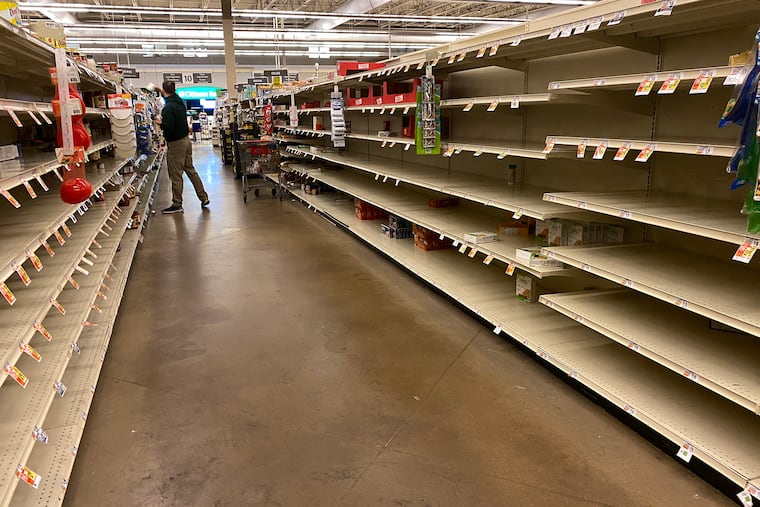Real-time data show the day that U.S. consumers reacted in a panic to the pandemic
Foot traffic shows day public noticed epidemic.

On the night of March 11, as the 76ers played the Detroit Pistons in South Philly, NBA execs tweeted that they were suspending the professional basketball season. As of 9:31 p.m., COVID-19 wasn’t a far-off distraction in China or Seattle but a health threat in Philadelphia and every city with a professional basketball team.
And it wasn’t just NBA fans who grasped the threat at that time.
The collective worry over a global pandemic crystallized the next day, as a wave of frantic shoppers surged into grocery stores to stock up on paper towels, toilet paper, milk, eggs, and other pantry foods on March 12, according to COVID-19 Retail Impact Tracker, a new online tool that shows daily foot traffic for 70 merchandise brands sold through thousands of stores.
ShopRite, with 14 locations in Philadelphia, saw a spike of 86% additional customers on March 12 as compared with the same date in 2019. The next day saw even more customers — 165% more shoppers went than in 2019.
Walmart shopper traffic jumped and then soared with 50% more shoppers on Friday, but the greatest spike at a grocery retailer was at wholesaler Costco, known for its selection of bulk items. Costco saw a 187% increase in shoppers on March 12.
(An earlier spike on Feb. 19 is unrelated to the coronavirus. That surge reflects the fact that shopping on that date a year before was unusually low due to a snowstorm.)
While the Great Recession of a decade ago is generally agreed to have been heralded by the bankruptcy filing of Lehman Brothers on Sept. 15, 2008, no single day or event looms as the moment the pandemic hit home in America. But the foot traffic data suggest that the second week of March 2020 was a pivotal period.
The COVID-19 Retail Impact Tracker foot traffic is measured from location software that the data and marketing firm Placer.ai shares with app developers free in exchange for anonymized aggregate foot traffic data, said Ethan Chernofsky, a Placer.ai vice president. “We do not collect or have access to any personally identifiable information,” he said. The software measures more than 80% of retail traffic, the firm says.
Restaurants decline as grocery stores rise
“The grocery industry is a double beneficiary here,” Neil Stern, senior partner at retail strategy firm McMillan Doolittle in Chicago. “People are stocking up and hoarding toilet paper and cleaning supplies. But grocery stores are also benefiting from restaurants closing.”
And what had been a 50-50 split between consumers eating at home and eating out has radically shifted with COVID-19, Stern said.
Now the split is more like 80% home-cooked meals and 20% outside of the home. Government restrictions have forced many restaurants to close their dining areas and offer only take-out. McDonald’s, for instance, saw foot traffic fall every day since March 10 — down, in fact, 53% on March 18 when compared with the same day a year ago.
The data tracker has even sniffed out nuanced trends. While consumers rushed to high-end grocery market Whole Foods on March 12, foot traffic to the chain faded in subsequent days. “If you were stocking up for a global pandemic, would you go to Costco or would you go to Whole Foods?” Stern asked.
Jump in home improvement
While supermarkets saw a flood of panic buying, grocery stores were not the only ones to see a rise in customers. People also have browsed the aisles of home improvement stores, the COVID-19 Retail Impact Tracker shows.
Home Depot saw a jump on March 12, with elevated foot traffic over the next few days that peaked on March 16 at 39% higher than in 2019.
Lowe’s stores saw a similar increase as Home Depot, with a March 16 jump of 36% and busier than usual starting on March 12.
Placer.ai made this tool available to help give insights to businesses during the pandemic. While social distancing is important, it obviously has a negative affect on businesses.
“We shouldn’t panic and think the sky is falling," said Chernofsky. “Once this ends, we want to be able to rebound and return to normalcy as quickly as possible. One part of that is data that shines light on what is happening.”